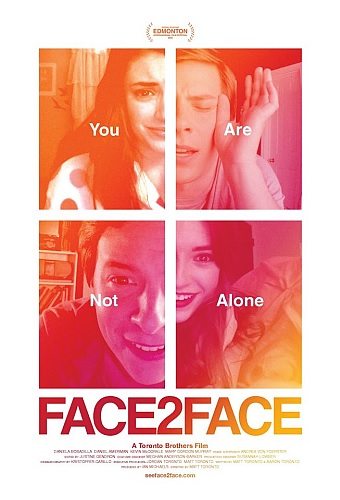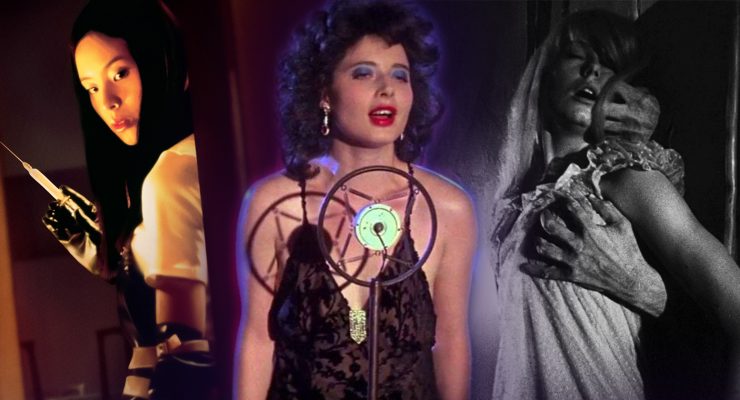Red Stewart chats with Face 2 Face creators Matthew and Jordan Toronto…
Matthew Toronto is an American filmmaker who has been working on independent movies since the mid-2000s. He made his directorial debut with the short subject Even Felons Fall in 2009, which he also produced. His first feature film was The Pact in 2011, which he co-wrote with his brother Aaron Toronto.
Jordan Toronto is American actor and writer, and the wife of Matthew. She made her acting debut in Matthew’s short film A Beam in Your Eye, and has continued to make appearances in other venues like The Happenstance. She has also helped with the development of the stories of a few projects by Matthew, including The Pact.
Flickering Myth had the honor to speak with both of them, and I in turn had the privilege to conduct it. We primarily talked about their latest film Face 2 Face as, though it was released in 2016, it made its Netflix debut in January 2018. You can see my review of it here, but in short I highly recommend watching it. Keep in mind that, if you are interested in viewing it, avoid reading this article as we discuss spoilers from the film.
I began by asking the duo what exactly Jordan’s role as the executive producer was. Executive producers are typically associated with the financing of a film, but in the blockbuster world we often see big names attached as executive producers even though they have no creative say on the direction of said film, from Steven Spielberg in the Transformers series to Stan Lee in the Marvel Cinematic Universe.
It turns out all the behind-the-camera roles on Face 2 Face blended. As Jordan tells me, “[Matt and I] did a lot of the funding together. Raised some money from a grant in Penn State, but funded most of it from our own personal finances.”
“[Penn State] funded a big part of the movie with a grant, but we needed a little bit more. Jordan was the one who said let’s put the house money on it,” chimed in Matthew. “Jordan also had a huge amount of artistic input in terms of developing the script, big picture hiring, and big picture financing.”
I was very interested in learning what it was like to work with such close family on a tight project like this, compared to other films where you’re working with strangers. Husband/wife collaborations are not as infrequent as people would think: Zack & Deborah Snyder, Judd Apatow & Leslie Mann, and Anna Boden & Ryan Fleck are three such couples off the top of my head. That being said, working with family has a chance of leading to disaster courtesy of personal issues being intermixed with the already stressful situation of getting a movie produced, shot, and distributed.
Luckily, Matthew and Jordan informed me that that was far from the case. “I know some people say that it’s hard to work with their spouse or brother, but it was a really joyful collaboration,” said Jordan. “I write a lot with both and we love it. So it was actually a great thing because we understand each other in a great way. We understand each other instantly.”
“And that’s true for my brother as well,” added Matthew. “We have a shorthand. We grew up together. We understand each other’s aesthetic. We communicate well. Being on a set is such a family type experience that having family there is an expansion of a normal thing. In terms of the difference [between the sets], though, you get into the zone quicker [with family]. When it’s a new collaboration, it can take a longer time to understand one another.”
“It’s a very different kind of film,” insists Jordan.
Still, even with a familial crew, Face 2 Face took some time to put together. A look on IMDB reveals that there was a five-year gap between The Pact and this movie in the Torontos’ filmography. I inquired Matthew as to what exactly caused this big delay. The truth is it wasn’t intentional: “It wasn’t that I meant to take a five year gap, but I was teaching at Penn State in the theater department and had to focus on that. So it wasn’t a hiatus from directing persay because I was directing theater in Penn State. Both Jordan and I actually have backgrounds in theater in New York. It was just our career was taking off in some ways that we couldn’t pursue the film world as much as we wanted to.”
Though it took some time before the Torontos could get back into the craft of film, the wait turned out to be beneficial. The world has changed significantly in the last 10 years or so primarily because of social media. “The idea,” says Matthew, “[for Face 2 Face] was invented when we were on many Skype calls. And we were like ‘what if this was a movie?’…The social media aspect was a new way to tell a story that was compelling and relevant. I think we’re all starting to feel how much of our lives are online.”
However, there was also a heartbreaking undercurrent to the narrative as it involved the real-life experiences of a close family member of Matthew’s: “I certainly think it was an interesting idea of watching a story evolve through social media,” said Jordan, “but the story itself, of the journey of Madison, was unfortunately based on someone close to Matt. He wanted to give voice to it.”
Speaking through waves of emotion, Matthew graciously disclosed it: “She was across the country from me, and I heard that she was being abused by her father. And this was when I was 20. And I remember feeling kind of helpless, but I couldn’t do anything to help her. And I think in some ways Face 2 Face is a reimagining of what I would have done if I had social media and could chat with her, or just drive across the country. It was just what I wish I could have done.”
Readers who have seen Face 2 Face will recall that this is exactly how the third act plays out, showcasing how strong Matthew’s personal ambitions were for the project. However, it wasn’t just his family member’s personal tragedy that affected the script, but various anecdotes related to his job at Penn State. “I was teaching at Penn State just as the Sandusky Scandal broke, and it hit the whole Penn State community. And I was working in theater and there were a lot of students that were talking about that, and talks of sexuality and suicide. Those were all a part of my world as a professor and they all made their way into my story. And even though I’m way past that generation at this point, I’m young at heart and I feel myself connected to them.”
Being knowledgeable of people who have those feelings and questions was also a part of the reason why Aaron was brought onto the project. “I reached out to my brother Aaron because he’s a therapist and he’s dealing with some of these same issues with his clients.”
Jordan also pointed out that her mother was a major factor when it came to the sideplot of Teel (Daniel Amerman) coming out of the closet: “A lot inspiration came from my mom being gay, and she has been very supportive of this film. After retiring she has always been saying that it’s her calling to be with gay teens, and now it turns out she’s a part of an organization that helps LGBT teens. Anyway, she has very wonderful stories too.” Stories that worked there way into Teel’s journey.
Writing from a male young adult’s perspective is one thing, but writing from a female young adult’s perspective is another task, especially if you are a male writer. Given this presumption, I inquired how much advice Jordan gave towards Madison’s characterization. “I think there were many times where he wrote a draft and I would be the dialogue police,” she said with a laugh.
“Jordan being a 15 year old girl at one point provided great insight,” stated Matthew “And some of the stories I’ve heard about Jordan’s teenage years crept into Madison. But it also evolved from teaching at Penn State. Just hearing girls interact with each other, I felt I had a good sense of how to capture their voice. What gave me the courage to explore all these characters is you bring that with you. And I remember being a teenager! And yes there were different problems with social media, but I remember what it was like. I don’t think being a teenager is that different from generation to generation.”
“Matt and I met when we were freshmen at college, so we were young adults interacting at one point,” noted Jordan.
Matthew also revealed that actress Daniela Bobadilla, who plays Madison, had a say in the direction of her character: “Daniela was very helpful. She had a script hat she really loved. But during the shooting process we would consult with her, and sometimes we nailed it and sometimes we didn’t, but she would help find the voice.”
One of the most unique aspects about Face 2 Face was that it was shot entirely on the GoPro Hero 4 camera. As I mentioned at the end of my review, I honestly could not tell the aesthetic difference between it and other motion pictures outside of one scene early on in the movie set at a pool party. Having the opportunity to speak with the creative minds behind this film, I had to ask them what that experience was like.
“Well I think from a philosophical standpoint, making a film is reliant on the story and how you tell it and how you perform it. And for us, the choice to go with GoPro had to do with capturing the feel of a real FaceTime conversation, and we wanted it to feel as authentic as possible,” stated Matthew.
When I pointed out that the concept was similar to Tangerine, a 2015 indie film that gained attention for being shot entirely on iPhone 5s, Matthew revealed a surprising connection to it: “We saw Tangerine, and one of the producers on that film actually made a small appearance in Face 2 Face that we had to unfortunately trim out. We thought about shooting [Face 2 Face] all on iPhone, but we found the GoPro gave us more freedom because we were going 360, and the remote options with the GoPro were really convenient. And regardless we discovered that we could imitate the iPhone look on the GoPro really well…We spent a lot of time trying to create a look. You’ve been on a FaceTime call: everyone doesn’t look good! That was something we worked hard on with our cinematographer Kristoffer Carrillo.”
Matthew continued by telling me how viable GoPros were from a production perspective. “It was very freeing because we got to shoot very quickly, and all we had to do was light the environment so that the actors could work the cameras and move them quickly. We shot the whole thing in nine days, with one of those days for pickup. The camerawork was all about the actors’ performance. What’s the best moment for moving the camera? How do we let that feel like it’s a part of the character and not a self-conscious decision made by a cinematographer or director? The whole process was really organic.”
Given the intimate reactions Bobadilla and Amerman have with each other, I was curious whether they interacted during the actual filming. The answer was both yes and no. “We filmed each side of the conversation individually. However, while we were filming, we had a GoPro mounted to the top of the laptop, and that’s all the footage that you see in the film. At the same time we had a live FaceTime coverage happening so that [the actors] could interact with each other and have genuine interactions. So, for example, when we shot Daniela’s side, we shot in the producer, Ian Michael’s, living room while the GoPro recorded the footage they were interacting. And Teel’s room was actually a room in the house that we were renting, and Daniela was just down the hall doing the other side of the scene.”
That kind of communication lent itself very well to the film’s synergy, creating an experience that, for me personally, was both ecstatic and surreal, but ultimately rewarding. Matthew and Jordan told me that they have heard from others who were also affected by it. “When it went on Netflix for the first time, a week or so later I got an email from a teenager that had seen the movie, and I assumed it was just going to be a review. But it was a little girl who had contemplated suicide, and that when she heard Teel’s story it made her change her mind.”
Jordan summarized it best: “There’s just a universal struggle. And with so many online connections, social media can make you feel more connected or amplify disconnection because people have changed so much. There’s this big spectrum of positive to negative in terms of the Internet changing people’s lives, from the hopeless feeling of ‘does anyone care’ to a glimmer of hope. So its hit a cord with so many people.”
“And I think what Jordan brings up is very great, because we deliberately set up this comparison in the beginning of the movie where Madison tries to help Teel find Facebook friends. The Facebook friends aren’t true. On the other hand the friendship the two create is different from that popularity.”
Suicide, depression, abuse, and the facade of online popularity are some of the mature themes that Face 2 Face deals with, and it is clear that Matthew, Jordan, Aaron, and everyone else involved in making the film added a level of authenticity to its production value. It doesn’t feel like you’re watching a flick about small-time problems plaguing high school kids, but rather a moving work that deals with issues we are increasingly encountering in today’s technological world.
And the best part is they all succeeded.
Many thanks to Matthew and Jordan Toronto for taking the time for this interview!
Red Stewart















